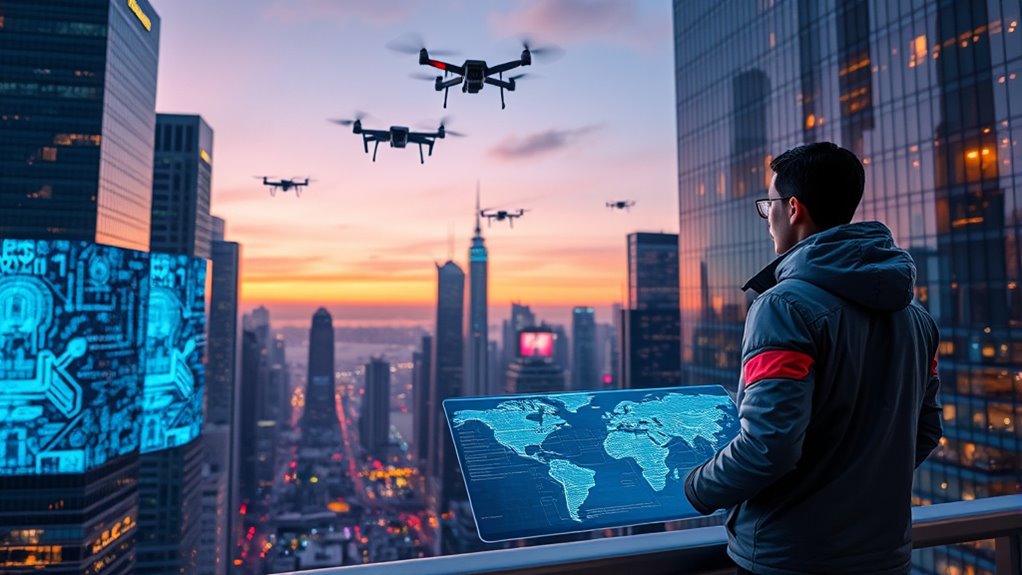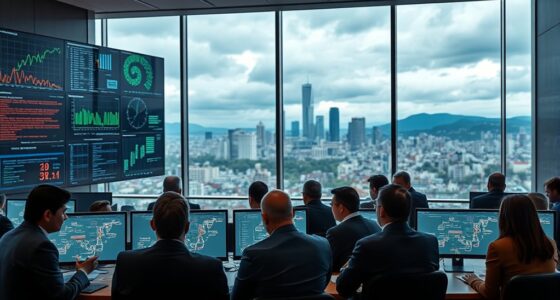By 2026, AI is transforming your printing operations through automation, predictive maintenance, and personalized design. It streamlines workflows, predicts equipment issues before they happen, and helps you craft tailored content efficiently. AI-driven tools make designs easier, reduce costs, and increase productivity. As systems become smarter and more responsive, your industry will evolve rapidly. Stay with us to discover how these innovations can shape your future in printing.
Key Takeaways
- AI will revolutionize print production with advanced automation, real-time scheduling, and smarter decision-making processes by 2026.
- Predictive maintenance powered by AI will significantly extend equipment lifespan and reduce operational costs.
- Design automation tools like Adobe Firefly will enable faster, professional-quality content creation without extensive expertise.
- Personalization through AI-driven data analysis will enhance targeted marketing and on-demand print solutions.
- Integration challenges remain, but AI’s role in optimizing workflows and unlocking creative potential will be central to industry evolution.

Artificial intelligence is transforming the printing industry by driving automation, improving efficiency, and enabling smarter decision-making. You’ll find AI integrated into various print processes, making operations smoother and less labor-intensive. For example, AI enhances web-to-print systems, automating content creation and design, so you spend less time on manual adjustments. It also helps dynamically schedule jobs based on current capacity, reducing bottlenecks and ensuring deadlines are met. This leads to faster turnaround times and higher productivity, giving you a competitive edge.
AI drives automation, boosts efficiency, and enhances decision-making in printing for faster, smarter operations.
Predictive maintenance is another key area where AI makes a difference. By continuously monitoring machinery through sensors, AI predicts potential failures before they happen. You can then schedule maintenance proactively, avoiding unexpected breakdowns that cause costly downtime. This not only saves money but also extends the lifespan of your equipment, ensuring you get maximum value out of your investments. With AI handling routine checks, your team can focus on more strategic tasks, streamlining workflows further. Emerging printing technologies and methods have further amplified AI’s capabilities, allowing for even more integrated and innovative solutions. Additionally, understanding software development lifecycle (SDLC) can help you better integrate AI tools with existing systems for smoother operations.
Design automation powered by AI is revolutionizing how you create print materials. Platforms like Adobe Firefly and Canva’s smart features simplify complex design tasks, allowing you to generate layouts and enhance images effortlessly. These tools help you deliver professional-quality designs faster, even if you’re not a seasoned designer. AI-driven content generation makes creative processes more accessible, enabling you to produce diverse, high-quality materials without sacrificing time or resources.
AI’s role in variable data printing (VDP) elevates personalization efforts. By analyzing customer data, AI helps you craft tailored messages and images at scale, strengthening your marketing campaigns. This personalization fosters better engagement and conversion rates, making your campaigns more effective. Additionally, AI improves demand forecasting, predicting print needs based on historical trends. This enables just-in-time and on-demand production, reducing inventory costs and waste.
Despite these advancements, integrating AI with legacy systems remains challenging. However, as AI continues to evolve, its ability to optimize processes, reduce errors, and release creative potential will shape the future of printing. By 2026, AI’s influence will be undeniable, transforming your operations into smarter, more efficient, and highly responsive systems at the crossroads of printing and prediction.
Frequently Asked Questions
How Will AI Impact Traditional Printing Industry Jobs?
AI will critically change your traditional printing jobs by automating routine tasks like file checks, color correction, and error detection, reducing manual labor. You’ll need new skills in managing AI systems, data analysis, and workflow integration. While some roles may diminish, your creativity and judgment remain vital for complex projects. Embracing these changes will help you stay relevant and leverage AI to enhance productivity and quality in your work.
What Ethical Concerns Arise With Predictive AI in Printing?
You might think predictive AI in printing is all about efficiency, but it raises serious ethical concerns. Bias in data can lead to unfair decisions or discrimination, and privacy issues emerge when handling sensitive info. Plus, accountability gets blurry when errors happen, making it hard to assign blame. As you rely more on AI, remember the importance of transparency, regular audits, and ethical training to avoid unintended harms.
Will AI Replace Human Creativity in Print Design?
AI won’t replace your human creativity in print design, but it will transform how you work. It automates repetitive tasks, suggests ideas, and speeds up production, allowing you to focus more on your unique concepts. You’ll still make the nuanced creative decisions, while AI handles technical and time-consuming aspects. Embrace AI as a tool that enhances your creativity, not as a replacement. Your innovative vision remains central to impactful print design.
How Secure Is Data Used for AI Predictions in Printing?
Your data’s security for AI predictions in printing isn’t foolproof yet. Visualize a high-tech vault with encryption, access controls, and real-time monitoring—these are your defenses. Still, vulnerabilities like cyberattacks or data breaches exist, especially with cloud integration and legacy systems. To stay protected, you need ongoing security updates, strict protocols, and employee training. While advancements boost security, staying vigilant is essential to prevent unauthorized access and safeguard sensitive information.
What Are the Environmental Implications of Ai-Driven Printing?
You should know that AI-driven printing substantially impacts the environment. It increases energy consumption, especially in data centers, and requires substantial water and hardware resources. While innovations like eco-friendly inks and recycling help reduce waste, the carbon footprint from AI training and operations remains high, mainly if powered by fossil fuels. To minimize this, adopting renewable energy and smarter processes is essential for sustainable AI printing practices.
Conclusion
As AI bridges the worlds of printing and prediction, you stand at a pivotal crossroads. While the printed page offers tangible permanence, AI’s predictive power promises dynamic foresight. This juxtaposition reminds you that, in embracing innovation, you balance tradition with transformation. The future isn’t just about new tools; it’s about how you choose to wield them—preserving the past while boldly shaping what’s to come. The stage is set, and your move defines the next chapter.










